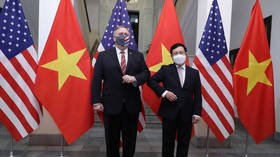The threat of China is all that unifies US, but Biden’s repackaged MAGA vision is unlikely to heal a divided nation
Joe Biden’s ambitious spending plan is underpinned by a desire, backed by Democrats and Republicans, to ensure the US can compete with China. But that’s where the consensus ends, and making his vision a reality will be difficult.
President Biden’s first address to Congress provided a fascinating insight into his vision for the United States. The president pledged to devote $4 trillion in spending, pitching it as a “once in a generation” investment in transport, elderly care, childcare, education and other infrastructure.
The cornerstones of his proposals are the American Jobs Plan and the American Families Plan, which promises free pre-school and child care support, among other measures, to be paid for by raising taxes.
What was notable, however, was how Biden sought to legitimise his plan for America with an anti-China undertone, describing a geopolitical struggle with Beijing as the competition of the 21st century, as Xi Jinping seeks to make China “the most significant, consequential nation in the world.”
Biden is typically considered a moderate centrist, not too left-leaning, yet his radical spending proposals deserve praise for their ambition at least. There can be few complaints about what he aims to achieve domestically, irrespective of feasibility.
His plans aim to strike a decisive break from the fiscal neoliberal consensus set in place by Ronald Reagan and lean towards the ‘New Deal’ vision of Franklin D. Roosevelt or Lyndon B. Johnson’s ‘Great Society’ – very much in line with Democrat traditions, encouraging the idea that the state should spend big and offer a more ready hand in society, as opposed to ‘limited government’.
Yet for something so different, Biden’s vision is also in many ways a continuation of a new status quo. The backdrop of China, his protectionist overtones and the repeated emphasis upon ‘US competitiveness’ are all familiar staples of the American political lexicon, and it is hard not to conclude that Biden’s ideas are built upon a repackaged version of ‘Make America Great Again’ (MAGA), but with Democrat characteristics.
Biden is continuing the trend of playing on the looming threat of a foreign adversary and arguing that America has lost ground, falling in status and prestige because of Beijing. Therefore, the focus of his policy, as was the case with his predecessor Donald Trump, is based upon a necessity that America must rekindle its glory and outclass China.
But the bipartisan consensus on being tough on China – at least on matters of foreign policy – does not translate into domestic unity in the way Biden would hope, and this is where the difficulties start. A blue MAGA is not a red one, because the vision of what America ‘should be’ remains inherently different to both sides, even if they can agree on the general concern over China.
Thus, the fundamental question of how the US remains competitive and revives itself remains highly contentious, with the result that Biden does not have much political leeway on issues such as taxes or spending. When considered from this angle, Biden cannot easily be the unifier he needs to be and will be just another player in what remains an extremely bitter and divided political arena. For example, while presenting his plan he referred to the Capitol riot as “the biggest attack on US democracy since the Civil War”, enraging those on the right.
On that note, the Republicans did not afford his speech a grain of praise, with Senator Tim Scott dismissing it out of hand as “socialist dreams”. It seems the desire to compete with Beijing is not sufficient to stop them railing against big government and taxes.
And so, although Biden made the argument that democracies are not less competitive despite the need to get consensus – contrasting with Beijing’s top-down, hierarchical party approach – the reality is very much that he needs to do that.
Presidents of the United States – as Roosevelt and Johnson demonstrated – have to articulate their vision by persuasion, forging consensus, showing strong leadership and of course, making compromises. FDR had the backdrop of the Great Depression, while Johnson was buoyed by the radicalism of the 1960s; both were times where US domestic politics fostered much deeper unity than at present.
Also on rt.com The cynical hypocrisy of the world’s No1 propagandist: US pledges $300mn to fund massive global anti-China media machineSo, what can be done in today’s environment? Does Biden have the charisma, guts and will to force his vision through in full? Can he help all corners of the political spectrum see the light regarding what is needed for America’s future?
What he pitched is a meaningful but theoretical vision, and one that he has to negotiate through the nit-picking gridlock of Congress. The actual result may be very different and less coherent than originally envisaged.
For all its flaws, the Trump administration was more suited to force through what it wanted because of its abruptness, unpredictability and often sheer disregard for the rules, even if the results were awful. His administration was the biggest upheaval America has seen in decades.
Biden is not capable of similar upheaval. He wants to be a unifier, but in an ultra-polarized America. In the next few months we will see the resolve of the new White House as it battles to frame a new US in light of the freshly minted adversary of China. Only time will tell how it goes.
Think your friends would be interested? Share this story!
The statements, views and opinions expressed in this column are solely those of the author and do not necessarily represent those of RT.















